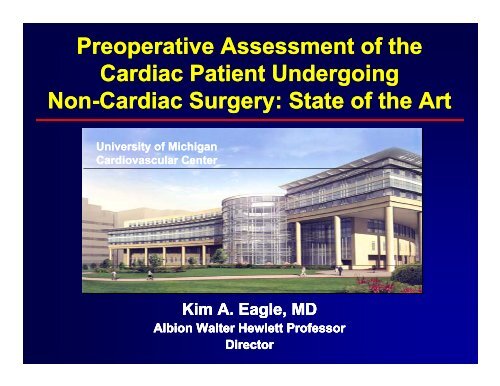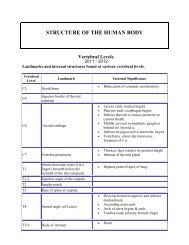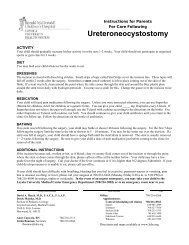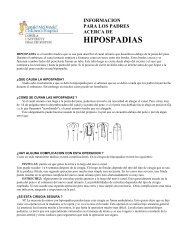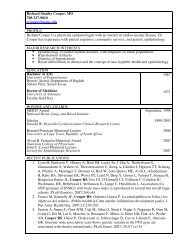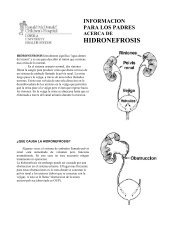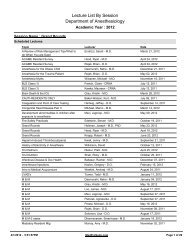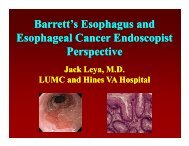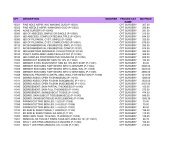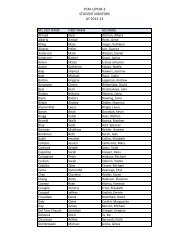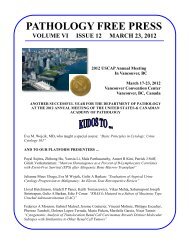Preoperative Assessment of the Cardiac Patient Undergoing ...
Preoperative Assessment of the Cardiac Patient Undergoing ...
Preoperative Assessment of the Cardiac Patient Undergoing ...
You also want an ePaper? Increase the reach of your titles
YUMPU automatically turns print PDFs into web optimized ePapers that Google loves.
<strong>Preoperative</strong> <strong>Assessment</strong> <strong>of</strong> <strong>the</strong><br />
<strong>Cardiac</strong> <strong>Patient</strong> <strong>Patient</strong> <strong>Undergoing</strong><br />
<strong>Undergoing</strong><br />
Non Non-<strong>Cardiac</strong> <strong>Cardiac</strong> Surgery: State <strong>of</strong> <strong>the</strong> Art<br />
University <strong>of</strong> Michigan<br />
Cardiovascular Center<br />
Kim Kim A. Eagle, MD<br />
Albion Walter Hewlett Pr<strong>of</strong>essor<br />
Director
Kim A. A Eagle Eagle, MD, MD FACC<br />
FACC<br />
Director<br />
University <strong>of</strong> Michigan<br />
Cardiovascular Center<br />
Grants Grants: : NIH, Hewlett Foundation,<br />
Mardigian Foundation, Varbedian Fund,<br />
GORE<br />
Cons Consultant: ltant NIH NHLBI
Lecture Outline<br />
• Estimating <strong>Patient</strong> Risk<br />
• Causes <strong>of</strong> Perioperative <strong>Cardiac</strong> Events<br />
• Role <strong>of</strong> Non Invasive Testing<br />
• Medical Therapy<br />
• Role <strong>of</strong> Revascularization<br />
• Approach to <strong>Preoperative</strong> Screening<br />
• Perioperative Management<br />
• Final Comments
Estimation <strong>of</strong> <strong>the</strong> <strong>Patient</strong>’s Risk<br />
Clinical Markers<br />
Functional Status<br />
Surgery - Specific Risk<br />
Proceed with Surgery Fur<strong>the</strong>r Evaluation/Mgmt<br />
Evaluation/Mgmt.<br />
Eagle KA, et al. JACC Guidelines 2002;39:542-53.
"Always Always make make things as<br />
as<br />
simple i l as possible......but ibl b t<br />
never more so."<br />
-Albert Albert Einstein
Independent Clinical Markers <strong>of</strong><br />
Elevated Perioperative Perioperative Risk<br />
Risk<br />
MMarker k RRelative l ti Risk Ri k CConfidence fid Limit Li it<br />
Known CAD 2.4 1.3 - 4.2<br />
Prior Heart Failure 1.9 1.1 - 3.5<br />
Diabetes 3.0 1.3 - 7.1<br />
RRenal l IInsufficiency ffi i 30 3.0 14 1.4 - 68 6.8<br />
Lee, et al. Arch Int Med 1999;159:2185-92.
Death<br />
. MI or<br />
Periop.<br />
10%<br />
Clinical Risk Status and<br />
5%<br />
0%<br />
V Vascular l Surgery S<br />
03% 0.3%<br />
Low Risk<br />
(0 markers)<br />
(n=1476)<br />
2.2%<br />
Intermediate Risk<br />
(1-2 markers)<br />
Clinical Risk Status<br />
85% 8.5%<br />
High Risk<br />
(≥ 3 markers)<br />
Poldermans et al. JACC 2006;48:964-969.
Risk<br />
Higher<br />
Lower<br />
Functional Status<br />
• Difficulty y with ADL<br />
• Can’t walk four blocks or<br />
up two flight <strong>of</strong> stairs<br />
• Inactive but no limitation<br />
• Active: Easily does<br />
vigorous tasks<br />
• Performs regular<br />
vigorous exercise<br />
Eagle KA, et al. JACC Guidelines 2002;39:542-53.
Mortality Data: Anaerobic Threshold<br />
Ab Above and d Below B l 11ml/min/kg<br />
11 l/ i /k<br />
Anaerobic CCardio-<br />
Threshold Vascular Percentage<br />
ml/min/kg l/ i /k NNo. DDeaths th MMortality t lit<br />
11 132 1 0.8<br />
Totals 187 11 p
Functional Status<br />
- Self Reported -<br />
EndPoint* Poor + Good p-value<br />
Complication ++ 20.4% 10.4%
Surgery g y - Specific Specific p Risk<br />
Higher<br />
• Aortic<br />
• Non-Carotid Peripheral<br />
Vascular<br />
• Major Thoracic<br />
•Major Abdominal<br />
• Carotid<br />
• Head/Neck<br />
• Orthopedic<br />
Lower • Eye Eye, Skin<br />
Risk j<br />
Eagle KA, et al. JACC Guidelines 2002;39:542-53.
“High Risk” Non <strong>Cardiac</strong> Surgery<br />
Known CAD CAD-Medical CAD CAD-Medical Medical Rx – Pre Beta<br />
Beta<br />
Blocker Era<br />
Type <strong>of</strong> Surgery # <strong>Patient</strong>s MI Death MI/Death<br />
Abd Abdominal i l 355 09% 0.9% 31% 3.1% 40% 4.0%<br />
Vascular 106 8.5% 2.8% 11.3%<br />
Thoracic 52 1.9% 5.8% 7.7%<br />
Head and Neck 69 4.4% 2.9% 7.3%<br />
“High High Risk Risk” 582 2.7% 3.3% 6.0%<br />
Eagle K, et al. Circulation 1997;96:1882-87.
Adjusteed<br />
Mortallity<br />
(%)<br />
12<br />
8<br />
4<br />
0<br />
Operative Mortality<br />
Carotid Endarterectomy<br />
1.7<br />
1.6<br />
1.6<br />
1.5<br />
1.5<br />
Lower-extremity bypass<br />
5.1<br />
4.8<br />
4.6<br />
4.8<br />
Elective repair <strong>of</strong> abdominal<br />
aortic aneurysm<br />
6.5<br />
5.2<br />
4.6<br />
41<br />
4.7<br />
4.1 39 3.9<br />
Birkmeyer et al. N Engl J Med 2002;346:1128-37.
“Low Risk” Non <strong>Cardiac</strong> Surgery<br />
Known CAD CAD-Medical Medical Rx – Pre<br />
BetaBlocker Era<br />
Type <strong>of</strong> Surgery # <strong>Patient</strong>s MI Death MI/Death<br />
Urologic 225 0.9% 0.9% 1.8%<br />
Orthopedic 159 0.6% 0.6% 1.2%<br />
“Low Risk” 484 0.8% 0.8% 1.6%<br />
Eagle K, et al. Circulation 1997;96:1882-87.
Cardiovascular Risk: Non <strong>Cardiac</strong><br />
S Surgery Surgery NSQIP Data: D t 2002 2002-2005 2002 2002-2005 2002 2005<br />
Procedure (n) ( ) Mortalityy Morbidityy Combined<br />
Endovascular<br />
AAA<br />
(600) 1.67% 12.83% 14.50%<br />
Carotid<br />
Endarterectomy<br />
(1717) 0.58% 8.44% 7.02%<br />
Parathyroid<br />
Surgery<br />
(1651) 0.42% 2.29% 2.71%<br />
Inguinal Hernia (4321) 0.14% 1.47% 1.61%<br />
Thyroidectomy (3041) 0.06% 1.51% 1.57%<br />
Breast (3855) 00.00% 00% 11.22% 22% 11.22% 22%<br />
Lumpectomy
Mortality After Bariatric Surgery<br />
Morttality<br />
5<br />
4<br />
3<br />
2<br />
1<br />
0<br />
2.0%<br />
(n=16,155) ( (n=16,155) 16 155)<br />
28% 2.8%<br />
4.5% %<br />
30 DDay 90 DDay 11-Year Y<br />
JAMA 2005;294:1903-08.
Predictors <strong>of</strong> Death at 30 Days:<br />
Bariatric Bariatric Surgery<br />
Women (1.5%) Men (3.7%)<br />
< 65 years (1 (1.7%) 7%) > 65 years (4 (4.8%) 8%)<br />
Independent Predictors <strong>of</strong> Death:<br />
>65yrs – 5 fold ↑<br />
Low Volume Operator p – 1.6 fold ↑
Independent p Predictors <strong>of</strong> Risk<br />
Clinical Markers<br />
CAD (RR 2.4)<br />
HF (RR 1.9)<br />
DM (RR ( 3.0) )<br />
Poor Functional Status (RR 1.8)<br />
Surgery - High Risk (RR 22.8) 8)<br />
Renal Insuf. (RR 3.0)
Questions:<br />
Who Needs Fur<strong>the</strong>r<br />
NonInvasive N NNonInvasive I i Testing? T ti ?<br />
1. Will test results lead to change in care?<br />
2. Has <strong>the</strong> patient been tested recently?<br />
3. Is <strong>the</strong> concern related to CAD or is LV<br />
DDysfunction f ti a concern? ?<br />
44. Can <strong>the</strong> patient do an exercise test?
Active <strong>Cardiac</strong> Conditions for Which <strong>the</strong><br />
<strong>Patient</strong> Should Undergo Undergo Evaluation Evaluation and<br />
Treatment Before Noncardiac Surgery<br />
(Class I, Level <strong>of</strong> Evidence: B)<br />
• Unstable coronary syndromes<br />
• Decompensated HF (NYHA functional<br />
class IV; worsening or new-onset HF)<br />
• Si Significant ifi t arrhythmias h th i<br />
• Severe valvular disease<br />
J Am Coll Cardiol. 2007;50;159-241.
Non<strong>Cardiac</strong> Testing Prior to Vascular<br />
S Surgery M Meta t Analysis A l i<br />
No. <strong>of</strong> No. <strong>of</strong> No. <strong>of</strong> Sensitivity, Specificity,<br />
Test studies patients events % (95% CI) % (95% CI)<br />
Radionuclide<br />
ventriculography g p y<br />
Ambulatory<br />
8 532 54 50 (32-69) ( ) 91 (87-96) ( )<br />
electrocardiography<br />
Exercise<br />
8 893 52 52 (21-84) 70 (57-83)<br />
electrocardiography<br />
Myocardial perfusion<br />
7 685 25 74 (60-88) 69 (60-78)<br />
scintigraphy<br />
Dobutamine stress<br />
23 3119 207 83 (77-89) 49 (41-57)<br />
echocardiography<br />
Dipyridamole stress<br />
8 1877 82 85 (74-97) 70 (62-79)<br />
echocardiography 4 850 33 74 (53-94) 86 (80-93)<br />
Devereaux, P.J. et al. CMAJ 2005;173:627-634.
<strong>Preoperative</strong> Thallium Study Performance<br />
N PPV NPV<br />
Boucher ‘85 48 19% 100%<br />
Cutler ‘87 116 20% 100%<br />
Fletcher ‘88 67 20% 100%<br />
Sachs ‘88 46 14% 100%<br />
Eagle ‘89 200 16% 98%<br />
McEnroe ‘90 95 9% 96%<br />
Younis ‘90 90 111 15% 100%<br />
Mangano ‘91 60 5% 95%<br />
Strawn ‘91 68 6% 100%<br />
Watters ‘91 26 20% 100%<br />
Hendel ‘92 327 14 99%<br />
Lette ‘92 355 17% 99%<br />
Madsen ‘92 65 11% 100%<br />
Brown ‘93 231 13% 99%<br />
Kresowik ‘93 170 4% 98%<br />
Baron ‘94 94 457 4% 96%<br />
Bry ‘94 237 11% 100%<br />
Koutelou ‘95 106 6% 100%<br />
Marshall ‘95 117 16% 97%<br />
Van Damme ‘97 142 N/A N/A<br />
Huang ‘98 106 13% 100%<br />
Cohen ‘03 153 4% 100%<br />
TOTAL 3303 12% 99%
<strong>Preoperative</strong> Dobutamine<br />
E Echocardiogram h di Performance<br />
P f<br />
N PPV NPV<br />
Lane ‘91 91 38 16% 100%<br />
Lalka ‘92 60 23% 93%<br />
Eichelberger ‘93 75 7% 100%<br />
Langan g ‘93 74 17% 100%<br />
Poldermans ‘93 131 14% 100%<br />
Davila-Roman ‘93<br />
88 10% 100%<br />
Poldermans ‘95<br />
302 24% 100%<br />
Shafritz ‘97 97<br />
42 NA 97%<br />
Plotkin ‘98<br />
80 33% 100%<br />
Ballal ‘99<br />
233 0% 96%<br />
Bossone ‘99<br />
46 25% 100%<br />
Das ’00 530 15% 100%<br />
Boersma ’01 1097 14% 98%<br />
Morgan ’02 78 0% 100%<br />
Torres ’02 02 105 18% 98%<br />
Labib ’04 429 9% 98%<br />
TOTAL 466 20% 99%
Which Stress Test?<br />
No Yes Test<br />
Can <strong>the</strong> patient exercise? x ETT<br />
Am I concerned about valve disease? x Echo<br />
Am I quantifying q y g muscle at risk? x Nuclear<br />
Am I concerned about false positive? x Echo<br />
Am I concerned about LV? x Echo/Nuke<br />
Role <strong>of</strong> CT and MR not yet clear
Clinical <strong>Assessment</strong><br />
Only<br />
1081 patients Bayes<br />
Theorem<br />
Low<br />
High<br />
3%(10/344) Moderate 18%(33/187)<br />
(1-7%) 8%(42/550) (12-24%)<br />
Dypridomole<br />
Thallium<br />
(6-10%)<br />
(p
What Causes Perioperative<br />
Cardiovascular C CCardiovascular di l Events? E t ?<br />
• Catecholamine surges<br />
• Prothrombotic milieau<br />
• Blood Loss<br />
• Volume Shifts<br />
• Coronary Plaque destabilization<br />
• Fixed Coronary Disease +<br />
+ Stress testing predicts only one <strong>of</strong> <strong>the</strong> six!
Fatal Perioperative MI<br />
Coronary C CCoronary P Pathology th l (n=42) ( 42)<br />
Coronary Stenosis Pathology<br />
(
Medical Therapy to Reduce<br />
P Perioperative i ti Events E t<br />
• Beta Adrenergic Blockers<br />
• Statins<br />
• Aspirin
Peri Peri-operative operative p Management g<br />
Eveent-Free<br />
Survival S (% %)<br />
Beta-blocker Rx (Atenolol) 1,2<br />
200 pts with or at risk for CAD<br />
Atenolol Discharge<br />
100<br />
90<br />
80<br />
Atenolol<br />
70<br />
60<br />
50<br />
Placebo Peri-op Ischemia<br />
No Hosp D/MI<br />
40<br />
30<br />
20<br />
10<br />
0<br />
P
Decrease Study y Design g<br />
Elective Aortic Surgery<br />
Clinical Markers <strong>of</strong> Risk<br />
Demonstrable Ischemia<br />
on<br />
Dobutamine Echo<br />
B-Blocker Blocker + Placebo<br />
+ Titrated over days/weeks<br />
NEJM 1994; 341:1749.
Perrcentage<br />
<strong>of</strong> o <strong>Patient</strong>ts<br />
40<br />
30<br />
20<br />
10<br />
Peri Peri-operative operative p Management g<br />
Beta Beta-blocker blocker Rx (Bisoprolol) 1<br />
High g risk vasc surgery g y<br />
Bisoprolol 7-89 7 89 days pre-op pre op (mean 37)<br />
St Standard d d care<br />
P
Do B B-Blockers Blockers Protect Protect Extremely Extremely High<br />
High<br />
Ri Risk k P <strong>Patient</strong>s ti t Having H i Vascular V l Surgery? S ?<br />
Preopera Preopera ative MI or De eath %<br />
3<br />
2<br />
1<br />
0 - 2 Clinical Markers > 3 Clinical Markers on Clinical Eval.<br />
2.3%<br />
20/855<br />
10<br />
0.8%<br />
2/263 2.3%<br />
2/86<br />
5<br />
< 4 Echo Segments<br />
<strong>of</strong> new WMA<br />
40<br />
10.6%<br />
12/121 36%<br />
4/11<br />
20<br />
> 5 Echo Segments<br />
<strong>of</strong> new WMA<br />
0 0 0<br />
B-Blocker No BB B-Blocker No BB B-Blocker No BB<br />
33%<br />
5/15<br />
Boersma, Poldermans, et al. JAMA 2001.
B-Blockers Blockers to to Lower Lower Vascular Vascular Surgical<br />
Surgical<br />
Ri Risk: k Influence I fl <strong>of</strong> f Pre Pre-op Pre Pre-op P op H Heart t R Rate t<br />
Periop P MI M or Death<br />
6%<br />
5%<br />
4%<br />
3%<br />
2%<br />
1%<br />
0%<br />
1.3%<br />
Heart Rate<br />
< 65 BPM<br />
p=0.003<br />
5.2%<br />
Heart Rate<br />
> 65 BPM<br />
Poldermans et al. JACC;48:964-969.
“I always like to use a<br />
new drug before its<br />
effectiveness wears <strong>of</strong>f”<br />
- William Osler
Effect <strong>of</strong> Perioperative BB-Blockade<br />
Blockade<br />
in Non-cardiac Non cardiac surgery among Medicare beneficiaries<br />
Among<br />
Ideal<br />
MMedicare di<br />
<strong>Patient</strong>s<br />
Treated<br />
with<br />
BBeta t Blockers Bl k<br />
(n=75,190)<br />
Not treated<br />
with<br />
BBeta t Blockers Bl k<br />
(n=260,238)<br />
Mortality 22.73% 73% 22.91% 91%<br />
Lindenaeur PK, Pekow P, Wang K, et al., Perioperative Beta Blocker Therapy and Mortality following<br />
major Non-cardiac Surgery. NEJM 2005;353:349-61.
Targeting Perioperative<br />
B B-Blockers Bl Blockers k to t <strong>the</strong> th “Right” “Ri ht” <strong>Patient</strong>s P ti t<br />
Revised <strong>Cardiac</strong> Risk Death Rate Odds Ratio #Needed: Treat #Needed: Harm<br />
Clinical Subgroup<br />
Score - 0<br />
Score - 1<br />
1.4% 1.36 - 208<br />
All 2.2% 1.09 - 504<br />
Diabetes 1.7% 1.28 - 209<br />
Isch Isch. Hrt Hrt. Disease 20% 2.0% 112 1.12 - 408<br />
Cerebro. Vasc. Dis. 9.0% 1.03 - 410<br />
Renal Insuff. 7.2% 1.01 - 1505<br />
High Risk Surgery 20% 2.0% 094 0.94 864<br />
Score - 2 3.9% 0.88 227<br />
Score - 3 5.8% 0.71 62<br />
Score - 4 7.4% 0.58 33<br />
Lindenaur PK, et al. NEJM 2005; 353:349-61.
“Evidence does not support<br />
<strong>the</strong> use <strong>of</strong> β-blocker <strong>the</strong>rapy<br />
for <strong>the</strong> prevention <strong>of</strong><br />
perioperative p p clinical<br />
outcomes in patients having<br />
non-cardiac surgery.”<br />
-The The Lancet
“One <strong>of</strong> <strong>the</strong> first<br />
duties <strong>of</strong> <strong>the</strong><br />
physician is to<br />
educate <strong>the</strong><br />
masses not ttto<br />
take medicine.”<br />
medicine.<br />
Sir William Osler<br />
(1849 – 1919)
*Average heart rate<br />
72 bpm - BB vs.<br />
78 bpm - Placebo<br />
Diabetic Postoperative<br />
Morbidity M MMorbidity bidit and d Mortality M t lit Trial T i l<br />
921 <strong>Patient</strong>s<br />
Diabetic/No known CAD<br />
B Blocker* Randomization Placebo*<br />
Atenolol 50mg evening prior to surgery<br />
Atenolol 100mg Q A.M.<br />
Non <strong>Cardiac</strong> Surgery<br />
Non <strong>Cardiac</strong> Surgery<br />
( (>50% 50% Abd. Abd or Orthopedic) O th di )<br />
( (>50% 50% Abd. Abd or Orthopedic)<br />
O th di )<br />
Combined In hospital endpoint, Mortality,<br />
MI, , Unstable angina, g , Heart failure<br />
21% (All cause death - 16% for both groups)<br />
20%
Peri erioperative perative Ischemic Is chemic Evaluation valuation<br />
30 Day Event<br />
Non Fatal MI<br />
CV Death, MI, ♥ Arrest<br />
Stroke<br />
Bradycardia<br />
Toprol XL<br />
100mg 22-4<br />
H Hrs P PPreop<br />
Preop→<br />
30 Days<br />
POISE POISE Trial T i l<br />
8351 <strong>Patient</strong>s +<br />
RRandomized d i d<br />
Placebo acebo<br />
+ >45yrs <strong>of</strong> age<br />
Had or at risk for<br />
A<strong>the</strong>rosclerosis<br />
A<strong>the</strong>rosclerosis-82% 82%<br />
Had CAD or PVD<br />
Toprol Placebo P-value<br />
3.6%<br />
5.1%
POISE Trial: Metoprolol vs. Placebo in<br />
<strong>Patient</strong>s <strong>Undergoing</strong> Noncardiac Surgery<br />
Peercent<br />
8 P=0.04 P=0.03<br />
6<br />
4<br />
2<br />
0<br />
5.8<br />
6.9<br />
CV Death, MI, or <strong>Cardiac</strong><br />
Arrest HR 0.83<br />
3.1<br />
23 2.3<br />
Total Mortality HR 1.33<br />
Metoprolol<br />
Placebo<br />
Devereaux PJ, et al. Lancet 2008;371:1839-47.
Independent Postoperative<br />
Predictors <strong>of</strong> Death<br />
Death<br />
Predictor HR 95% CI<br />
Stroke 12.74 7.77-20.88<br />
Hypotension 4.32 3.22-5.80<br />
Symptomatic MI 3.51 2.02-6.11<br />
Asymptomatic MI 280 2.80 187419 1.87-4.19<br />
Bradycardia 1.99 1.35-2.92<br />
Bleeding 1.54 1.09-2.16
Negative Consequences <strong>of</strong><br />
Sudden Discontinuation Discontinuation <strong>of</strong> <strong>of</strong> Beta Beta-<br />
Blockers after Hip Surgery<br />
Van Klei et al. Anes<strong>the</strong>siology 2009;111:717-24.
Recommendations for Beta-Blocker<br />
Class I<br />
MMedical di l Therapy Th<br />
1. Beta blockers should be continued in patients<br />
undergoing surgery who are receiving beta blockers<br />
to treat angina, symptomatic arrhythmias,<br />
hypertension, or o<strong>the</strong>r ACC/AHA Class I guideline<br />
iindications. di ti (L (Level l <strong>of</strong> f EEvidence: id C)<br />
2. Beta blockers should be given to patients undergoing<br />
vascular surgery who are at high cardiac risk owing<br />
to <strong>the</strong> finding <strong>of</strong> ischemia on preoperative testing.<br />
(L (Level l <strong>of</strong> f EEvidence: id B)<br />
Fleisher L, et al. J Am Coll Cardiol 2007:50:1707-1732.
Recommendations for Beta Beta-Blocker<br />
Beta Beta-Blocker Blocker<br />
CLASS IIa<br />
M Medical di l Therapy Th<br />
1. Beta blockers are probably recommended for patients<br />
undergoing vascular surgery in whom preoperative<br />
assessment identifies CHD. CHD (B)<br />
2. Beta blockers are probably recommended for patients<br />
in whom preoperative assessment for vascular<br />
surgery identifies high cardiac risk, as defined by <strong>the</strong><br />
presence <strong>of</strong> more than one clinical risk factor. (B)<br />
3. Beta blockers are probably recommended for patients<br />
in whom preoperative assessment identifies CHD or<br />
high cardiac risk, as defined by <strong>the</strong> presence <strong>of</strong> more<br />
than one clinical risk factor, who are undergoing<br />
intermediate-risk or vascular surgery. (B)
High g Dose β-Blockers Blockers given g<br />
indiscriminately <strong>the</strong> evening<br />
before or morning <strong>of</strong> surgery<br />
may cause as many events as<br />
<strong>the</strong>y prevent!
How Do I Use Beta Blockers?<br />
• Metoprolol 25mg BID titrating up to<br />
achieve HR ≤ 60<br />
• Prefer to begin several weeks<br />
preoperatively<br />
• Still use in patients with only<br />
relative contraindications
• 100 vascular<br />
surgery patients<br />
• 20mg atorvastatin<br />
or placebo l b ffor 445<br />
days<br />
• Vascular surgery<br />
an average <strong>of</strong> 30<br />
ddays after ft<br />
RCT <strong>of</strong> Statins<br />
Evvent-free<br />
Survival S (%) (<br />
100<br />
80<br />
60<br />
40<br />
20<br />
0<br />
Days after Surgery<br />
At Atorvastatin t ti<br />
Placebo<br />
P = 0.018<br />
0 30 60 90 120 150 180<br />
randomization Atorvastatin 50 44 43 41 40 40 40<br />
Placebo<br />
50 38 36 35 34 33 33<br />
Durazzo et al. J Vasc Surg 2004;39:967.
In-hospital Mortality after Non-<strong>Cardiac</strong><br />
S Surgery: Lipid Li id lowering l i <strong>the</strong>rapy th<br />
4% 3.05%<br />
2%<br />
0%<br />
2.13%<br />
Lipid p Rx No Lipid Rx<br />
(OR 0.71;<br />
95% CI<br />
0.67-0.75)<br />
Lindenauer PK, et al. JAMA 2004;291:2092-99.
Allocated to Fluvastatin (n= 250)<br />
R Received i d allocated ll t d i intervention t ti<br />
(n= 247)<br />
Lost Lost to to follow follow-up up up at at 30 30 days days (n (n=0) 0)<br />
Temporarily discontinued (n=61)<br />
Permanently discontinued (n=16)<br />
Assessed for Eligibility<br />
(n=1669)<br />
Enrollment<br />
Randomization<br />
All Allocation ti<br />
Follow Follow-up up<br />
Excluded (n=1172)<br />
Not meeting inclusion criteria (n=356)<br />
St Statin ti users ( (n=798) 798)<br />
O<strong>the</strong>r reasons (n=18)<br />
Allocated to Placebo (n= 247)<br />
Received allocated intervention<br />
(n= 246)<br />
Lost Lost to to follow follow-up up at 30 days (n (n= 0)<br />
Temporarily discontinued (n=54)<br />
Permanently discontinued (n=18)<br />
N = 250 Analysis<br />
N = 247<br />
Dutch Echographic <strong>Cardiac</strong> Risk Evaluation Applying Stress Echo III
Carddiac<br />
death<br />
or nonnfatal<br />
MII<br />
(%)<br />
15<br />
12<br />
9<br />
6<br />
3<br />
0<br />
N Engl J Med. 2009;361:984.<br />
DECREASE III<br />
P = 0.039<br />
Placebo<br />
Fluvastatin<br />
0 5 10 15 20 25 30<br />
Days after surgery
DECREASE IV<br />
Eligible<br />
45,000<br />
6,460<br />
1,421<br />
Included<br />
Low or High Risk<br />
Beta-Blocker and/or<br />
Statin Therapy<br />
Informed Consent,<br />
Previous Participation<br />
Excluded<br />
38,540<br />
(86%) ( %)<br />
55,039 039<br />
(78%)<br />
355<br />
(25%)<br />
1,066<br />
(2.4%)
Outcome: Primary End Point<br />
Log-rank p-value 0.003 Log-rank p-value 0.17 Log-rank p-value 0.003<br />
8% 8% 8%<br />
6% 6% 6%<br />
4% 4% 4%<br />
2%<br />
2%<br />
0% 0%<br />
0%<br />
0 15 30 0 15 30 0 15 30<br />
Bisoprolol vs.<br />
Fluvatatin vs.<br />
Combination vs.<br />
Bisoprolol-Control Fluvastatin-Control<br />
Double Control<br />
2%<br />
Days after surgery<br />
Dunkelgrum M, et al. Ann Surg 2009;249:921-926.
Recommendations for Statin Therapy<br />
Class I<br />
1. For patients currently taking statins and scheduled<br />
for noncardiac surgery surgery, statins should be continued continued.<br />
(Level <strong>of</strong> Evidence: B)<br />
Class IIa<br />
1. For patients undergoing vascular surgery with or<br />
without clinical risk factors, statin use is reasonable.<br />
(Level <strong>of</strong> Evidence: B)<br />
Fleisher L, et al. J Am Coll Cardiol 2007:50:1707-1732.
Aspirin in CVD<br />
Antithrombotic Trialists BMJ 2002;324:71–86.
Wh What t About Ab t Prior P i Coronary C<br />
Revascularization?<br />
Does It Lower Risk?
Influence <strong>of</strong> Prior CABG to Lower<br />
Risk Ri Risk k <strong>of</strong> f Periop, P i MI/Death MI/D th<br />
Pre Pre-operative operative CABG Surgery: CASS Registry<br />
% <strong>Patient</strong>s P<br />
5<br />
4<br />
3<br />
2<br />
1<br />
1.7<br />
p=0.03 p=0.002<br />
3.3<br />
0.8<br />
2.7<br />
n=1961<br />
Hi High h Ri Risk k<br />
CABG<br />
Med Rx<br />
0<br />
Deaths MI<br />
• Greatest risk reduction with MVD, MVD more severe angina<br />
• ECSG, CASS: CABG vs Med Rx in pts with CAD and PVD<br />
Eagle KA, et al. Circulation 1997;96:1882-87.
Influence <strong>of</strong> Prior CABG vs. PTCA<br />
on Ri Risk k in i Non<strong>Cardiac</strong> N C di S Surgery<br />
First Non-<strong>Cardiac</strong> CABG PTCA p-value<br />
Surgery n=250 n=251<br />
<strong>Cardiac</strong> Events 4(1.6%) 4(1.6%) 1.00<br />
DDeath/MI th/MI 2/2 2/2 11.00/1.00 00/1 00<br />
First High risk n=120 n=109<br />
Surgery<br />
<strong>Cardiac</strong> Events 2(1.7%) 2(1.8%) 1.00<br />
All Non-<strong>Cardiac</strong> n=538 n=511<br />
Procedures<br />
<strong>Cardiac</strong> Events 7(1.3%) 8(1.5%) 0.80<br />
DDeath/MI th/MI 5/2 6/2 00.77/1.00 77/1 00<br />
Hassan SA, et al. Am J Med 2001;110:260-66.
What About Immediate<br />
Coronary Revascularization<br />
To Lower Risk?
Surgery After (bare metal) Stent Implantation –<br />
Methodist Hospital Houston<br />
Stent<br />
SSurgery 1-14d 1 14d Surgery 15-39d 15 39d<br />
(n=25) (n=15)<br />
Results Pt<br />
(%)<br />
• 8 deaths<br />
•6 due to MI<br />
•2 due to bleeding<br />
• 11 bleeds<br />
• 3/5 pts t operated t d on<br />
ticlid died (1 bleed – 2<br />
MI+ bleed)<br />
6 <strong>of</strong> 7 pts died<br />
(86%)<br />
MI<br />
Death<br />
40 P=0.015<br />
20<br />
0<br />
28.0<br />
32.0<br />
0.0 0.0<br />
1-14 days >14 days<br />
Kaluza et al, JACC 2000
Death/MI after Non <strong>Cardiac</strong> Surgery<br />
i in <strong>Patient</strong>s P ti t with ith Recent R t Bare B Metal M t l Stent St t<br />
5%<br />
4%<br />
3%<br />
2%<br />
1%<br />
0%<br />
4.8%<br />
(8/168)<br />
0%<br />
(0/39)<br />
PCI ≤ 6 weeks PCI ≥ 7 weeks<br />
Before Surgery Before Surgery<br />
J Am Coll Cardiol 2003;42:234-40.
Bare Metal Coronary Stenting<br />
Prior to Noncardiac Surgery †<br />
Bare Metal Coronary Stenting<br />
Prior to Noncardiac Surgery †<br />
Prior to Noncardiac Surgery †<br />
Prior to Noncardiac Surgery †<br />
Event ≤30 Days ++ Event ≤30 Days 31 90 Days >90 Days OR P value<br />
++ 31-90 Days >90 Days OR P-value<br />
MACE + 10.5% 3.8% 2.8% (3.6, 1.6) 0.003<br />
(47/899; 5.2%)<br />
Bleedingg 6.9% 4.6% 3.6% (1.3, ( 0.7) ) 0.46<br />
(43/899; 4.8%)<br />
† Nuttall GA,et al. Anes<strong>the</strong>siology 2008;109:588-595.<br />
+ MACE – 31 deaths, 12 Q-MI, 6 non-Q MI, 9 Stent thrombosis, 12 repeat revascularization.<br />
++ Time from BMS to noncardiac surgery.
DES and Non-cardiac Surgery: Erasmus Data<br />
4/30<br />
1/162<br />
1999-2005<br />
Surgery g y within 2 yrs y<br />
from PCI (n=192)<br />
n=13<br />
n=17<br />
n=99<br />
n=93<br />
5 ffatal t l MIs MI in i 192 pts t<br />
2.6% (95% CI 0.9-6%)<br />
(stent thrombosis in 4)<br />
J Am Coll Cardiol 2007;49:122-5.
Day Stennt<br />
Thrombbosis<br />
(%) )<br />
30<br />
10<br />
8<br />
6<br />
4<br />
2<br />
Stent Thrombosis After<br />
Non<strong>Cardiac</strong> Non<strong>Cardiac</strong> Surgery<br />
p = 0.014<br />
0<br />
000 0.00 025 0.25 050 0.50 075 0.75 100 1.00 125 1.25 150 1.50 175 1.75 200 2.00 225 2.25 250 2.50 275 2.75<br />
Time from PCI with DES (yrs)<br />
Anwaruddin S, et al. JACC Intv 2009;2:542-9.
CARP: Coronary Revascularization<br />
P Prophylaxis h l i before b f Major M j Vascular V l Surgery S<br />
Vascular<br />
<strong>Patient</strong>s<br />
Screening<br />
Process<br />
Coronary<br />
Angiography<br />
Study St Study d <strong>Patient</strong>s<br />
(n=510; 8.7%)<br />
(n=5859)<br />
(n=4669; 79.7%)<br />
(n=380; 11.6%)<br />
Surgical Indications for <strong>the</strong> Trial<br />
• Abdominal Aortic Aneurysm (n=1935)<br />
• Claudication (n=1528)<br />
• Rest Pain (n=981)<br />
• Tissue Loss (n=1415)<br />
Clinical Exclusions from <strong>the</strong> Trial<br />
• Insufficient cardiac risk (n=1654)<br />
• Urgent/Emergent surgery (n=1025)<br />
• Prior CABG/PCI and no ischemia (n=626)<br />
• Co-morbid condition (n=731)<br />
• Refusal or non-eligible (n=633)<br />
Anatomical Exclusions from <strong>the</strong> Trial<br />
• Non-obstructive coronary arteries ( (n=363) )<br />
• Not amenable to revascularization (n=215)<br />
• Left Main Stenosis > 50% (n=54)<br />
• LV Ejection Fraction < 20% (n=11)<br />
• Refusal (n=29)<br />
McFalls EO, et al. N Engl J Med 2004;351:2785-804.
Baseline Clinical Variables: CARP<br />
Clinical Variables Revascularization No Revascularization P-value<br />
(N=258) (N=252)<br />
Hi History t<br />
Age (years) 65±11.1 67.2±10.4 0.099<br />
Angina (%) 39.9 37.7 0.606<br />
PPrior i MI (%) 43 43.0 0 40 40.9 9 00.623 623<br />
Prior CHF (%) 12.0 7.5 0.089<br />
Diabetes (%)<br />
Laboratory<br />
37.6 40.0 0.840<br />
LDL (mg/dL)<br />
<strong>Cardiac</strong> Status<br />
105±37 107±42 0.596<br />
LV Ejection Fraction 54±12 55±12 00.363 363<br />
3-vessel CAD (%)<br />
Indications for Surgery<br />
35.4 31.4 0.685<br />
Abdominal aneurysm (%) 34 34.4 4 32 32.1 1 00.613 613<br />
Claudication (%) 38.8 35.3 0.613<br />
Rest pain (%) 11.6 13.9 0.613
CARP: Main Results<br />
Revasc. No Revasc. P-value value<br />
(N=225) (N=237)<br />
Surgical Management<br />
Abdominal Surgery (%) 39.9 42.1 0.890<br />
Urgent or Emergent (%) 5.8 5.9 0.900<br />
General G GGeneral l anes<strong>the</strong>sia th i (%) 81.1 81 81.1 1 84.3 84 84.3 3 0 0.499 499<br />
Perioperative Medications<br />
Beta Beta-adrenergic adrenergic adrenergic blockers (%) 83.9 83 83.9 9 86.4 86 86.4 4 0 0.448 448<br />
Aspirin (%) 76.1 70.0 0.163<br />
Statins (%) 53.5 54.0 0.925<br />
Postoperative Events<br />
Death (%) 3.1 3.4 0.873<br />
MI (enzymes ( y and ECG) ) ( (%) ) 7.6 6.8 0.737<br />
Loss <strong>of</strong> Limb 0.5 0.9 0.114<br />
McFalls EO, et al. N Eng J Med 2004;351:2785-804.
CARP: Long-Term Long Term Survival Survival in in <strong>the</strong><br />
<strong>the</strong><br />
Probability<br />
<strong>of</strong> Survival<br />
1.0<br />
0.8<br />
0.6<br />
04 0.4<br />
0.2<br />
0.0<br />
T Two Randomized R d i d Groups G<br />
Assigned to No Coronary Artery Revasularization<br />
Assigned to Coronary Artery Revasularization<br />
0 1 2 3 4 5 6<br />
Survival Time (Years)<br />
McFalls EO, et al. N Engl J Med 2004;351:2795-804.
Long Term Survival in CARP (2 (2-5 (2 (2-5 5 Yrs)<br />
Yrs)<br />
Survival S Post-Vasculaar<br />
Surgery<br />
1<br />
09 0.9<br />
0.8<br />
0.7<br />
0.6<br />
0.5<br />
04 0.4<br />
0.3<br />
0.2<br />
0.1<br />
0<br />
2-Vessel 3-Vessel Left Main Prior CABG<br />
(N=204) (N=130) (N=48) (N=225)<br />
Medical<br />
Treatment<br />
<strong>Preoperative</strong><br />
Revascularization<br />
Garcia S, et al. Am J Cardiol 2008;102:809-15.
Survival S Poost-Vasculaar<br />
Surgery<br />
1.0<br />
0.8<br />
0.6<br />
04 0.4<br />
0.2<br />
CARP: Left Main Survival<br />
P=0.007<br />
(+) <strong>Preoperative</strong> Revascularization<br />
(-) <strong>Preoperative</strong> Revascularization<br />
0<br />
0 1 2 3<br />
4<br />
Time Following Vascular Surgery (Years)<br />
Garcia S, et al. Am J Cardiol 2008;102:809-15.
But should we we revascularize revascularize <strong>the</strong><br />
<strong>the</strong><br />
coronaries <strong>of</strong> stable patients<br />
with “many” many clinical markers markers (≥3)<br />
and major major ischemia ischemia on D D-Echo?<br />
Echo?
DECREASE DECREASE – V V Pilot Pilot Study<br />
Study<br />
PreOp<br />
PreOp p Coronary Coronary y Revascularization<br />
Pre Pre-Major Pre Pre-Major Major Vascular Vascular Surgery<br />
Surgery<br />
1 – yr composite<br />
MI or Death<br />
Cath<br />
1880 1880 Pts Pts Screened<br />
101 Pts<br />
Randomized<br />
3 or more clinical markers<br />
(+)<br />
Major j ischemia on DSE<br />
(±5 5 segments or ≥ 3 walls)<br />
52 Pts Pts 49 Pts<br />
Pts<br />
PCI – 32 Pts Medical Rx<br />
CABG – 17 Pts Only<br />
24 (49%) 22 (44%)<br />
No Cath<br />
JACC 2007;49:1763-9.
<strong>Cardiac</strong> Risk <strong>of</strong> Vascular Surgery<br />
DES - 30<br />
Aft After R Recent t DES<br />
49 49 High High Risk Risk <strong>Patient</strong>s<br />
<strong>Patient</strong>s<br />
Coronary<br />
PCI - 32 CABG - 17<br />
Revascularization<br />
Non <strong>Cardiac</strong><br />
Surgery<br />
BMS -2 Q – Wave MI - 11<br />
STE – 7/11 pts; 5 <strong>of</strong> 7<br />
in Stented Coronary<br />
Despite Dual Antiplatelet Rx.<br />
Poldermans. JACC; 2007.
Revascularization Before<br />
N NNon Non-<strong>Cardiac</strong> Non Non-<strong>Cardiac</strong> C <strong>Cardiac</strong> di Surgery S<br />
DECREASE-V Pilot Study<br />
Incidence <strong>of</strong> All-Cause Death or Myocardial Infarction During Follow-Up<br />
Revascularization<br />
Medical <strong>the</strong>rapy<br />
Revascularization<br />
Medical <strong>the</strong>rapy<br />
JACC 2007; 49:1763.
Timing<br />
<strong>of</strong><br />
Surgery<br />
Perioperative Guidelines<br />
Acute MI, high-risk high risk ACS, or high high-risk risk cardiac anatomy<br />
Bleeding risk<br />
<strong>of</strong> surgery<br />
Not Low<br />
Low<br />
Stent and continued<br />
dual dual-antiplatelet<br />
antiplatelet<br />
<strong>the</strong>rapy<br />
(COR IIb/LOE C)<br />
14 to 29 days 30 to 365 days Greater than 365 days<br />
B Balloon ll<br />
angioplasty<br />
BBare Bare-metal metal t l<br />
stent<br />
DDrug Drug-eluting eluting l ti<br />
stent<br />
(COR IIb/LOE C) (COR IIa/LOE C) (COR IIb/LOE C)<br />
TTreatment t t for f patients ti t requiring i i percutaneous t coronary intervention i t ti who h need d subsequent b t<br />
surgery. ACS indicates acute coronary syndrome; COR, class <strong>of</strong> recommendation; LOE,<br />
level <strong>of</strong> evidence; and MI, myocardial infarction.<br />
Fleisher L, et al. JACC 2007;50:1707-32.
Coronary Revascularization before<br />
Class III<br />
NNon-<strong>Cardiac</strong> C di Surgery S<br />
It is not recommended that routine<br />
prophylactic coronary revascularization<br />
Be performed p in stable CAD before non-<br />
cardiac surgery.<br />
Fleisher L, et al. J Am Coll Cardiol 2007:50:1707-1732.
Who Needs Coronary y Angiography?<br />
g g p y<br />
• Indicators are <strong>the</strong> same as for patients p not<br />
being seen for preop evaluation<br />
• Unstable or poorly controlled symptoms on<br />
medical Rx<br />
• Stable patients with likelihood <strong>of</strong> advanced<br />
multivessel CAD +/- LV Dysfunction facing<br />
high stress surgery<br />
Eagle KA, et al. JACC Guidelines 2002;30:542-63.
Who Should I Screen<br />
Before<br />
Non <strong>Cardiac</strong> Surgery?
Potential Approach<br />
pp<br />
1. Stable Clinical<br />
Markers and/or Not<br />
Revascularization<br />
candidate<br />
• Angina, q-waves, prior<br />
MI<br />
– Beta Blocker +<br />
Statin + ASA<br />
• SSystolic t li hheart t ffailure il<br />
– Beta Blocker, ACE<br />
inhibitor, , Aldo<br />
inhibitor<br />
2. Multiple p Markers, , • Stress Echo<br />
established CAD or<br />
HF, and high risk<br />
surgery<br />
• Rarely Cath if severe<br />
ischemia in large regions<br />
• BBest t medical di l RRx bbased d<br />
on history & stress echo
Potential Approach<br />
pp<br />
3.Unstable CAD •Cath<br />
and/or HF<br />
• Revascularize those<br />
eligible<br />
4.Non-cardiac<br />
markers<br />
only…DM, Age, <br />
creatinine<br />
• B-Blocker if HTN<br />
• Statin if lipids
Perioperative p Pain Management g<br />
• EEpidural id l or PCA with i h more<br />
complete relief <strong>of</strong> pain reduces<br />
catecholamine surges<br />
•This may y reduce perioperative<br />
p p<br />
ischemia or infarction
Recommendations for<br />
Post Post-operative Post Post-operative operative Surveillance<br />
• <strong>Patient</strong>s without evidence <strong>of</strong> CAD<br />
– Surveillance restricted to those who develop<br />
perioperative signs <strong>of</strong> cardiovascular<br />
dysfunction<br />
• <strong>Patient</strong>s with known or suspected CAD, and<br />
undergoing g g high g or intermediate risk procedure:<br />
p<br />
– ECG’s at baseline, immediately after procedure,<br />
and daily x 2 days<br />
– <strong>Cardiac</strong> troponin measurements 24 hours<br />
postoperatively and on day 4 or hospital<br />
discharge (whichever comes first)<br />
2002 ACC/AHA Guidelines for Perioperative Cardiovascular Evaluation for Noncardiac Surgery
Post Operative Therapy and<br />
F Future t Considerations<br />
C id ti<br />
• <strong>Patient</strong>s suffering recurrent postop ischemia ischemia,<br />
ischemic CHF, or nonfatal MI have 2-3 fold risk<br />
<strong>of</strong> MI or cardiac death over next 4 years<br />
• Their subsequent risk stratification and treatment<br />
should be aggressive<br />
• Perioperative evaluation and treatment may<br />
identify important cardiovascular problems and/or<br />
risk factors for <strong>the</strong> first time. Appropriate longterm<br />
goals g should be defined and relayed y to<br />
patients primary physicians
Axioms <strong>of</strong> Periop p <strong>Assessment</strong><br />
• Foundation <strong>of</strong> coronary management<br />
in patients undergoing non-cardiac<br />
surgery g y is identical to foundation <strong>of</strong><br />
strategies for coronary patients in<br />
general g<br />
• The preoperative moment may<br />
represent <strong>the</strong> first chance for a patient<br />
to have an appropriate coronary<br />
evaluation<br />
l ti
Resource Use and Outcomes After<br />
Implementation Implementation <strong>of</strong> <strong>of</strong> ACC/AHA ACC/AHA <strong>Preoperative</strong><br />
Risk <strong>Assessment</strong> Guidelines<br />
Resource I II III P-value P-value<br />
Utilization “Post “Late Post<br />
“Controls” Guideline” Guideline” I vs. II I vs. III<br />
( (n=102) 102) ( (n=94) 94) (104)<br />
Stress Test 90 (88%) 44 (47%) 43 (41%)
Resource Use and Outcomes After<br />
Implementation Implementation <strong>of</strong> <strong>of</strong> ACC/AHA ACC/AHA <strong>Preoperative</strong><br />
Risk <strong>Assessment</strong> Guidelines<br />
Resource I II III P-value P-value<br />
Utilization “Post “Late Post<br />
Outcomes<br />
“Controls” Controls Guideline” Guideline Guideline” Guideline I vs. II I vs. III<br />
(n=102) (n=94) (104)<br />
Death 4 (4%) 3 (3%) 0 (0%) 0.77<br />
MI 7 (7%) 3 (3%) 5 (5%) 0.24<br />
Death or MI 11 (11%) 4 (4%) 5 (5%) 0.08<br />
J Vasc Surg 2002;36:758-63.
“Prediction Is Very Difficult,<br />
Especially p y About The Future”<br />
- Niels Bohr Bohr, Danish Physicist
Former President Bush Visit
“M “Medicine di i is i an Art A<br />
<strong>of</strong> fU Uncertainty, t i t and d a<br />
Science S SScience i <strong>of</strong> f Probability”<br />
P b bilit ”<br />
- Si Sir Willi William Osler<br />
O l


